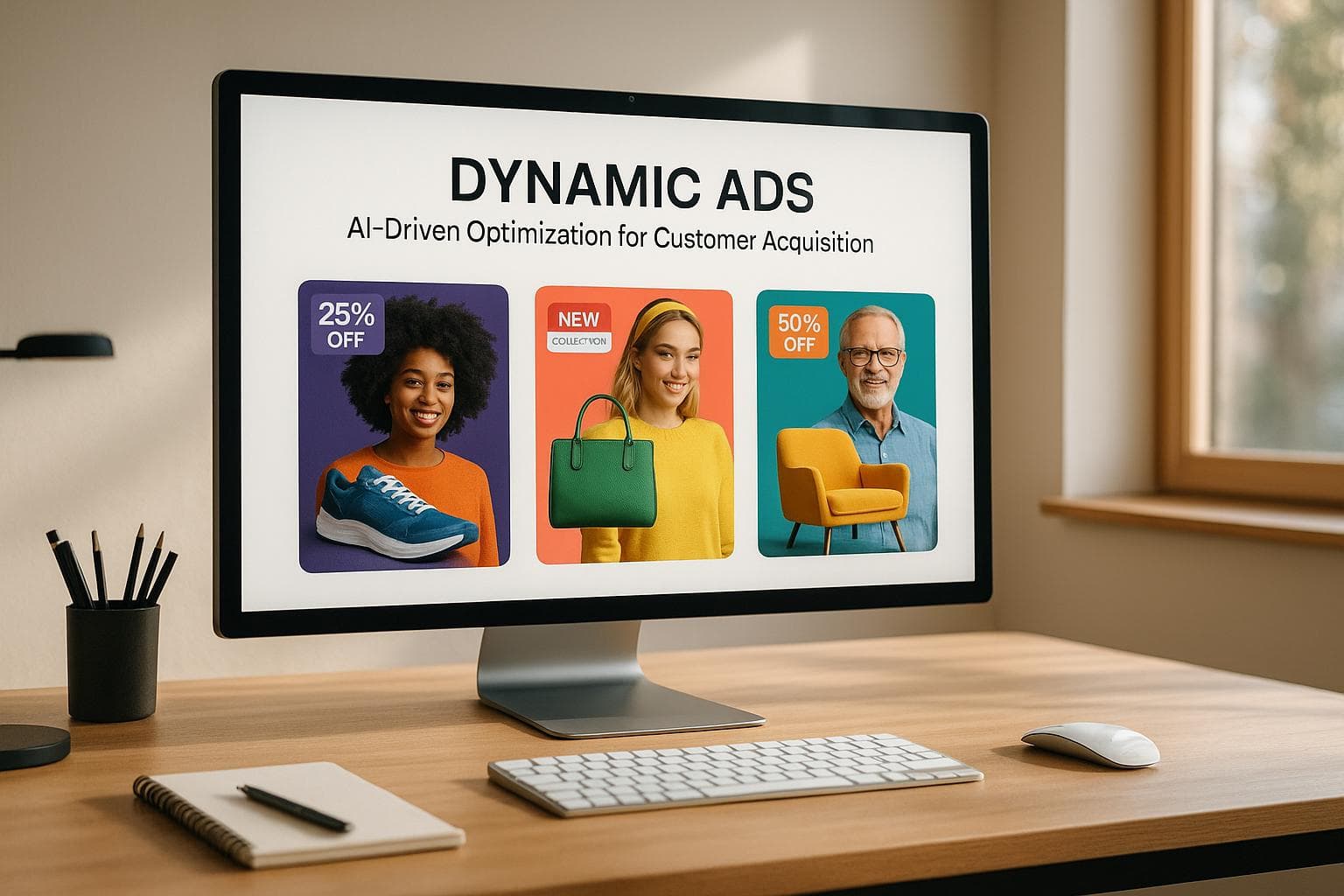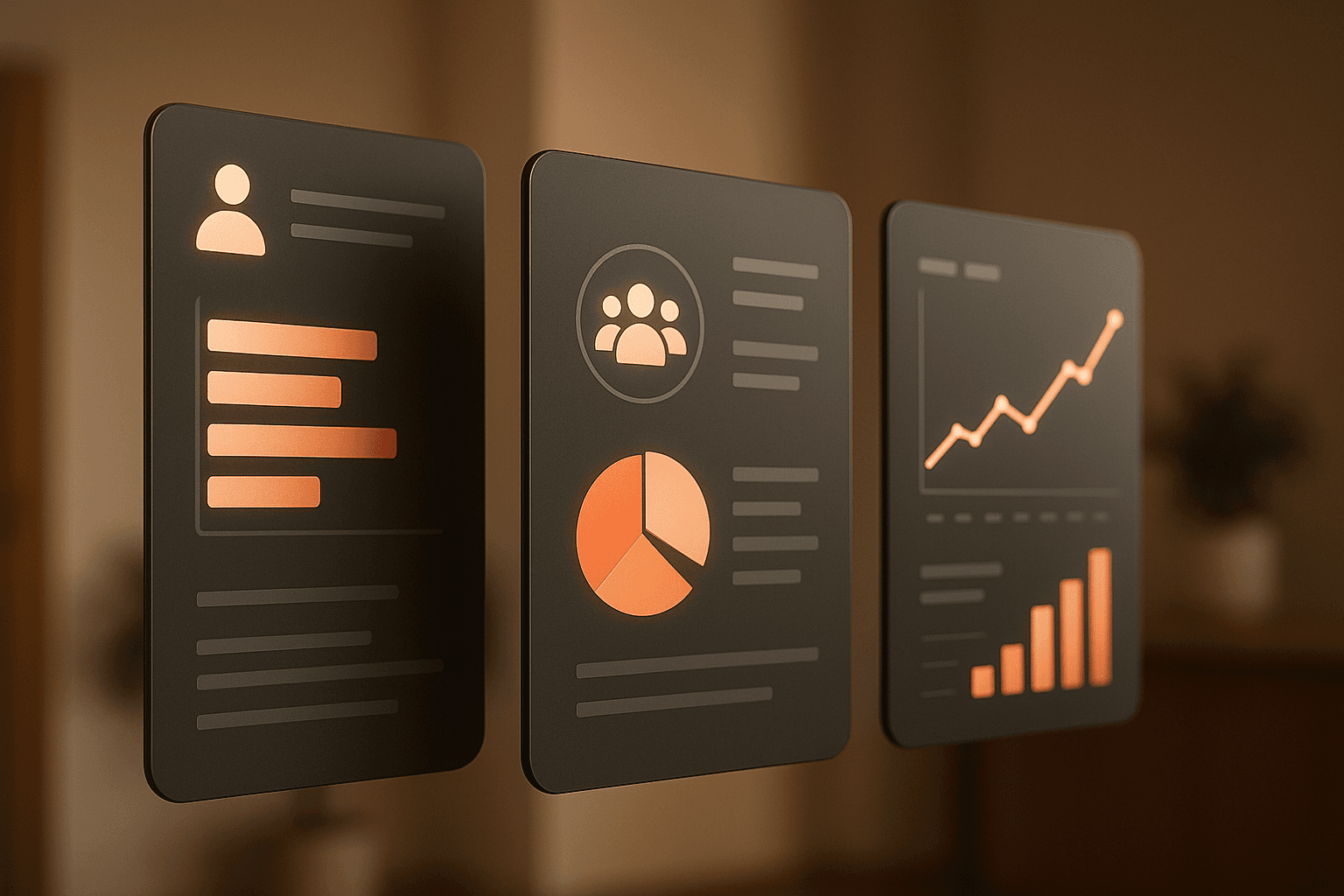Multichannel Ad Management: Complete Guide for 2025
Learn how multichannel advertising can boost customer retention and ROI in 2025 with AI-driven strategies and tailored campaign designs.
Managing ads across multiple platforms is no longer optional - it’s essential in 2025. With consumers using multiple devices and channels daily, businesses using multichannel advertising see 91% higher customer retention and a 24% higher ROI compared to single-channel strategies. Here’s what you need to know to succeed:
Why it Matters: 76% of shoppers buy products they first discover on social media, and smartphones now account for 71% of global retail traffic.
What’s New in 2025: AI drives 85% of customer interactions and powers 90% of marketers’ content creation, enabling hyper-personalized ads and automated campaign management.
Key Steps:
Set clear goals and track metrics like ROAS, CTR, and LTV.
Focus on core platforms where your audience is most active.
Leverage AI for precise targeting, budget optimization, and ad testing.
Design platform-specific ads to maximize engagement.
Use attribution models to track performance and refine strategies.
Bottom Line: Multichannel advertising is the key to staying competitive in today’s digital landscape. Start with data-driven strategies, embrace AI tools, and tailor your ads for each platform to see measurable growth.
Multichannel at Scale: Using Ad Automation and AI for Better Outcomes with Fewer Resources
Planning Your Ad Strategy
Crafting a well-thought-out advertising strategy is a must. With 86% of consumers regularly using at least two channels during their shopping journey [2], having a clear plan ensures you're reaching your audience effectively. Start by defining your goals and deciding how you'll measure success.
Setting Goals and Metrics
Every multichannel advertising strategy should begin with specific, measurable goals that align with your overall business objectives. Focus on key performance indicators (KPIs) to track progress. Here's a breakdown of some common goal types and their corresponding metrics:
| Goal Type | Key Metrics |
|---|---|
| Awareness | Impressions, Reach |
| Engagement | CTR (Click-Through Rate), Social Interactions |
| Conversion | ROAS (Return on Ad Spend), CPA (Cost Per Acquisition) |
| Retention | Customer Lifetime Value (LTV) |
By assigning clear objectives to each channel, you can allocate resources more effectively and evaluate your campaign's success with greater precision [1].
Selecting Ad Platforms
Choosing the right platforms is crucial to reaching your audience and maximizing your return on investment. With digital channels projected to account for 72.7% of global ad spending [4], focus on platforms where your audience is active and where your ad dollars can work hardest. Keep these factors in mind:
Audience Presence: Prioritize platforms where your target audience spends the most time.
Platform Performance: Look at historical data to determine which channels deliver strong ROI for your industry.
Content Format: Choose platforms that support the types of ads you plan to create, whether that's video, display, or interactive content.
Budget Distribution
Companies leveraging multichannel strategies see a 24% higher ROI compared to those sticking to just one channel [3]. To make the most of your budget, consider this allocation framework:
Core Channels (70%): Dedicate the majority of your budget to proven platforms that consistently deliver results.
Growth Channels (20%): Invest in channels that show promise but might still need further testing.
Experimental Channels (10%): Reserve a small portion of your budget for testing new platforms and ad formats.
An adaptable budget strategy, guided by performance analytics, can significantly improve outcomes. Businesses that use data analytics in their multichannel campaigns report a 15-20% boost in marketing effectiveness [3].
AI and Automation Tools
As businesses adopt more complex multichannel strategies, AI tools have become essential for precise targeting, automation, and data management. In fact, AI technologies contribute up to $2.6 trillion in value to marketing and sales efforts [7], reshaping how companies optimize their advertising operations.
Smart Audience Targeting
AI-powered audience targeting allows advertisers to connect with potential customers more precisely than ever before. A striking 88% of marketers report that AI has improved their ability to personalize campaigns [7]. By analyzing user behavior patterns, AI predicts the best targeting strategies and continuously refines them based on performance data. Here’s how:
| Targeting Feature | Benefits |
|---|---|
| Behavioral Analysis | Predicts user intent and identifies the best times for engagement |
| Dynamic Segmentation | Automatically updates audience groups based on real-time performance |
| Cross-Channel Matching | Finds similar audiences across different platforms for better reach |
This level of precision not only enhances targeting but also reduces manual tasks by automating campaign management.
Campaign Automation
AI simplifies campaign management by automating complex tasks, significantly reducing the manual workload. For example, Harley Davidson saw a staggering 2,930% increase in monthly leads after incorporating AI automation [6]. Some standout features include:
Real-time Bid Adjustments: AI fine-tunes bids based on factors like user intent, demographics, and time of day [5].
Dynamic Budget Allocation: Automatically distributes advertising funds across channels based on performance data.
Performance Monitoring: Continuously analyzes and adjusts campaign settings to maximize results.
Beyond campaigns, AI also streamlines other advertising operations, such as managing product feeds.
Product Feed Management
Managing product feeds becomes much more efficient with AI, with 80% of users reporting improvements in efficiency [8]. Here’s what AI brings to the table:
Automated Data Enhancement: AI fills in missing attributes and optimizes product titles to ensure consistency across platforms.
Smart Categorization: Automatically organizes products according to platform-specific taxonomies, boosting visibility.
Performance Optimization: For example, interior design brand bimago used AI-driven personalization to increase conversion rates by 44% [9].
With nearly half (47%) of marketers now relying on AI for ad targeting [7], these tools are proving indispensable for scaling advertising efforts across multiple platforms. As the technology advances, it continues to offer smarter, more efficient solutions for businesses navigating the complexities of modern e-commerce.
sbb-itb-0bd1697
Ad Design for Multiple Platforms
Creating ads that work across various platforms means understanding each channel's unique features while keeping your brand identity intact. In 2025, successful multichannel advertising will rely on smart design strategies that combine platform-specific best practices with AI-driven tools for optimization.
Platform-Specific Design Rules
Each platform has its own set of requirements. Here’s how to tailor your ad designs for the major players:
| Platform | Key Design Requirements | Best Practices |
|---|---|---|
| Amazon | High-quality product images, keyword-rich descriptions | Highlight product benefits, encourage reviews |
| Clear CTAs, responsive formats | Add star ratings (boosts CTR by 17%) | |
| Facebook/Instagram | Visual storytelling, mobile-first design | Use UGC (lowers CPC by 13.9%) |
For example, shoppers spend 45% more time on Amazon compared to other marketplaces [10]. This means Amazon ads should focus on driving purchase intent, while Facebook ads should engage users earlier in their decision-making process. By adapting designs to fit each platform, your campaigns can maintain strong performance across the board.
AI-Powered Ad Testing
AI is transforming how ads are designed and optimized. A Fortune 500 automotive company saw a 52% boost in their Year-End sales campaign by leveraging AI [11]. Here are some key ways AI supports ad testing:
Dynamic Content Generation: Automatically creates multiple ad variations to test.
Performance Prediction: Uses historical data to predict which designs will perform best.
Real-Time Optimization: Tweaks creative elements on the fly based on live performance metrics.
With 76% of marketers now using AI for copywriting and 60% for instant image creation [12], these tools are no longer optional - they’re a must-have for staying competitive.
Adding Customer Content
User-generated content (UGC) has a proven track record of boosting ad performance.
"Whether you use Amazon, Google, or Facebook, your ad needs to clearly communicate and stand out - and it has to be at scale. Quality and quantity go together." [10]
- Nityashree Yadunath, More, Rocketium.com
The numbers back this up:
Facebook ads featuring reviews see a 300% higher CTR and 50% lower CPC [13].
Websites with reviews experience a 45% increase in traffic [13].
Landing pages that include testimonials improve conversion rates by as much as 34% [14].
Top brands like Apple [15] and IKEA [15] effectively use UGC to showcase their products in real-world scenarios. Considering that 84% of people trust online reviews as much as personal recommendations [13], incorporating customer feedback into your ad designs can dramatically enhance campaign results.
Next, we’ll dive into performance tracking methods to measure the success of these design strategies.
Performance Tracking and Updates
Once your campaigns are up and running, keeping a close eye on performance is crucial for refining strategies and driving growth.
Main Performance Metrics
Tracking the right metrics is key to achieving success across multiple channels. Research shows that companies with robust multichannel marketing strategies experience a 9.5% boost in annual revenue [16]. Here's a breakdown of the most important metrics to monitor:
| Metric Category | Key Indicators | Target Goals |
|---|---|---|
| Revenue | ROAS, Revenue per Channel | Minimum 2:1 ROAS ($2 revenue per $1 spent) [22] |
| Engagement | CTR, Time on Site | Exceed industry benchmarks by channel |
| Conversion | CAC, Conversion Rate | Monitor across 4-5 channels [18] |
| Customer Value | LTV, Retention Rate | Aim for a 91% retention rate [16] |
With modern campaigns requiring up to 18 touchpoints before a conversion [18], thorough tracking is non-negotiable to understand and optimize the customer journey.
Attribution Modeling
By 2025, AI is expected to transform how we track and analyze customer journeys. For instance, research from impact.com highlights that while paid social channels excel at building awareness and driving traffic, conversions often occur through paid search [18].
"AI has turned attribution from a reporting function into a performance lever. It makes strategy sharper, budgets more efficient, and outcomes more measurable." - The MNTN Team [19]
AI-powered attribution tools offer game-changing capabilities:
Analyze data across multiple touchpoints.
Remove biases in decision-making.
Deliver real-time insights.
Connect online behaviors to offline sales [21].
With 80% of marketing budgets now focused on digital channels [21], accurate attribution is more critical than ever. AI tools can help unify customer data, tracking everything from online interactions to in-store purchases [20].
Regular Performance Updates
Once attribution tools are in place, staying on top of performance metrics ensures you can quickly address any shifts or issues.
Track engagement, CTR, and conversion rates consistently [22]. For immediate improvements, run weekly A/B tests with at least 100 clicks per test [22]. On a monthly basis, review how each channel is performing, refine attribution models, and prepare detailed reports for stakeholders [17].
Given that 58.21% of global internet traffic now comes from mobile devices [22], evaluating mobile performance is essential. Leverage analytics tools to gather data regularly and set up dashboards that give you a clear view of performance across all channels [16].
Next Steps for Growth
To thrive in today's competitive market, multichannel advertising isn't just a nice-to-have - it's a must. Research shows that campaigns using three or more channels can boost purchase rates by an impressive 287% compared to sticking with just one channel [23]. Here's how to make the most of your multichannel strategy:
Start With Core Channels
Focus your efforts on platforms where your audience is already active. For instance, 75% of shoppers begin their search on Google [26]. Build a strong foundation by establishing a presence on two or three primary channels before branching out. This approach helps maintain quality while gaining traction.Implement Data-Driven Automation
Data should be at the heart of your advertising strategy. Eric Mayhew from Fluency puts it best:
"Anchoring on your data and understanding the value of your data is key to any automation strategy. Centering your entire advertising strategy around data offers you both convenience and functionality so that you can operate many different ad networks all from one central seat. Data becomes the key, central component of a hub and spoke solution." [24]
Using data effectively allows you to streamline processes and manage multiple ad networks with ease.
Scale Through Platform-Specific Optimization
The multichannel marketing market is expected to grow from $11.67 billion in 2025 to $29.17 billion by 2034 [27]. To stay competitive, tailor your campaigns to each platform's unique strengths. Whether it’s creative formats or targeting capabilities, optimizing for the specifics of each channel is crucial.Embrace Advanced Personalization
Personalization matters - a lot. In fact, 37% of shoppers spend more when they receive personalized recommendations [25]. Use AI-powered tools to segment your audience based on behavior and identify lookalike audiences that mirror your most valuable customers.
Scaling successfully requires a commitment to ongoing measurement and refinement. The e-commerce market is projected to exceed $4.3 trillion by 2025 [26], and adopting these strategies will help you secure your share. By staying data-driven and continually optimizing your multichannel approach, you'll keep your growth trajectory on track.
FAQs
How can businesses use AI to enhance their multichannel ad management strategies in 2025?
In 2025, businesses looking to manage their multichannel advertising more efficiently can turn to AI-powered tools. These tools are game-changers when it comes to optimizing campaigns and targeting the right audiences. By crunching massive amounts of data, AI can reveal customer preferences and behaviors, making it easier to deliver highly tailored ads on platforms like Google, Facebook, and Amazon.
AI doesn’t just analyze - it takes action. Tasks like ad creation, bidding, and distribution can be automated, cutting down on errors, saving time, and boosting productivity. Plus, with real-time analytics, businesses can adjust their strategies on the fly to ensure they're getting the best return on investment (ROI) possible. Incorporating AI into your ad management not only simplifies processes but also makes your marketing efforts far more impactful.
What are the most important KPIs to monitor for a successful multichannel advertising strategy?
When managing a multichannel advertising strategy, keeping an eye on the right KPIs is key to measuring success and improving performance. Here are some of the most important ones to keep track of:
Conversion Rate: This tells you the percentage of users who take a specific action - like making a purchase or signing up - after engaging with your ads. It’s a direct indicator of how well your campaigns are driving results.
Return on Ad Spend (ROAS): This metric shows how much revenue your ads generate for every dollar spent. It’s a clear way to gauge the profitability of your advertising efforts.
Customer Acquisition Cost (CAC): This tracks the total expense of bringing in a new customer. It helps you understand how cost-efficient your campaigns are in growing your customer base.
Click-Through Rate (CTR): This measures how often people click on your ad after seeing it. A higher CTR typically means your ad creatives and targeting are on point.
By concentrating on these KPIs, you can make smarter, data-backed decisions to fine-tune your campaigns and get the most out of your advertising budget across all channels.
How can businesses effectively allocate their advertising budget across core, growth, and experimental channels to maximize ROI?
To make the most of your advertising budget in 2025, consider applying the 70-20-10 rule for allocation:
70% goes to proven channels that consistently perform well, like Google Ads or Facebook.
20% is reserved for channels with growth potential that can scale effectively.
10% is dedicated to experimenting with new strategies and testing emerging platforms.
This method strikes a balance between maintaining reliable results and exploring fresh opportunities. The secret to making this work? Keep a close eye on performance data. Shift your budget toward the channels that deliver the best returns. For instance, focusing on high-intent audiences often yields stronger results, underscoring the importance of data-driven decisions in maximizing your ROI.
Yohann B.










